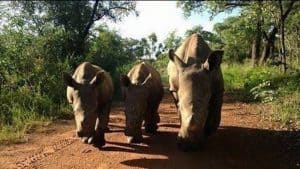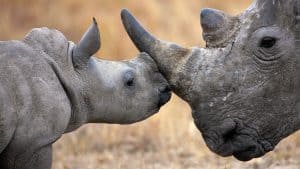 Rescuing the calves of poached rhinos is key to preserving this endangered species. Lesley Stones(@lesley_stones) met several role players who are involved in this important work.
Rescuing the calves of poached rhinos is key to preserving this endangered species. Lesley Stones(@lesley_stones) met several role players who are involved in this important work.
AFRICA IS FIGHTING A LOSING BATTLE against rhino poaching, with efforts to capture poachers rarely snagging the kingpins. Educational initiatives to stifle demand have also proved futile because rhino horn is desired as a status symbol, as well as a sex aid (for which purpose it is actually entirely ineffective).
But one initiative that could help save the species is focused on rescuing calves that are orphaned when a female rhino is slaughtered. Young rhinos are dependent on their mothers’ milk for up to three years, which is why so many poached females have a calf by their side. Without help, these calves die from injuries or dehydration, or are killed by hungry predators.

This is the sharp end of the battle where traumatised orphans must be located, transported to a rehabilitation center and treated for any injuries, then carefully reared until they’re old enough and strong enough to be returned to the wild. In years to come, these calves will reproduce, slowly restocking the rapidly declining population.
Several non-profit organisations which are involved in rescuing calves of poached mothers united earlier this year to form the Now or Never African Wildlife Trust (NNAWT).Founder members are the Rhino Orphanage, Care for Wild Africa, Saving the Survivors, Tsavo Trust and Youth 4 African Wildlife. Pooling their efforts enables them to share best practices and boost access to the medical expertise necessary to save injured calves. In addition, presenting a united front gives the trust greater firepower to obtain international donations.
The partners fear that they currently find only 20% of orphaned calves.
“We have gone past the tipping point. We have to save all the orphans – every single one,” says Chris de Bruno Austin of Care for Wild Africa.
Rhino poaching has increased substantially since 2007, with an average of 1200 – 1600 known incidents per year. This leaves a great many dead mothers and hundreds of calves that will also die unless they are rescued and reared in safety.
“Considering the number of rhinos left in the world, it’s absolutely essential to rescue, treat and heal every single rhino we come across now. If you save a young calf, you are not saving only one animal. When you put it back into the wild it can have five or six calves later,” says veterinarian Prof Johan Marais of Saving the Survivors.
“THERE’S NO POINT IN SPENDING R200 000 A MONTH ON HELICOPTERS, R50 000 ON A SORTIE TO BRING A CALF IN AND HUNDREDS OF THOUSANDS OF RANDS ON VET BILLS ONLY TO LOSE THE ANIMAL.”
Treating injured rhinos and nurturing calves to maturity are still experimental fields and Marais has become an expert in rhino surgery. He saves up to 100 animals a year with surgeries that include face repairs for rhinos whose horns have been hacked off.
NNAWT’s first goal is to negotiate for instant access to helicopters when game rangers alert them to a poaching. While helicopters are often used to track poachers, a dedicated chopper on 24-hour standby would allow them to sweep the area using detection technology and night vision to locate a calf. It could also be used to airlift a distressed baby to safety once its tranquillised.
Trust spokesman Pete Richardson says negotiations are underway with various helicopter companies to arrange this quick, essential access. Richardson was a co-founder of South Africa’s first rhino orphanage, which opened in 2012 at the Legend Golf & Safari Resort at the Entabeni Game Reserve in Limpopo.
Another goal is to establish a wider network of vets who are able to provide immediate medical treatment and hone best practices for the rearing of calves.
At the moment, the surviving babies can be treated and raised in safety in two rhino orphanages before being released in two well-protected reserves. NNAWT plans to increase that number to 10 safe havens, which will involve erecting fences and hiring security guards for the chosen locations.
Security will be the biggest expense, but is vital to ensure that none of the calves are poached in later years.
NNAWT will also have a strong educational focus and will visit schools and communities around game reserves and national parks to stress that rhinos are a valuable resource to protect, not cash cow to target.
Global technology company Google is another co-founder of the Trust, and is helping with free advertising and by exploring technologies that could aid the fight. Google representative Thomas Ropel says: “Our first tactical goal is to fund two helicopters on 24-hour standby in key areas to save more injured and orphaned animals. The first 24 hours are crucial and we need to reach more animals more quickly.”
Article taken from Sawubona Magazine September 2017.
